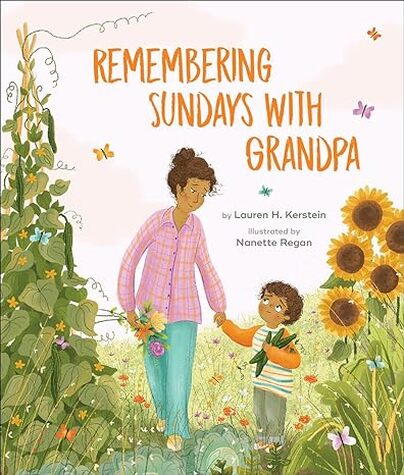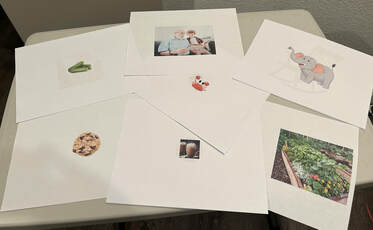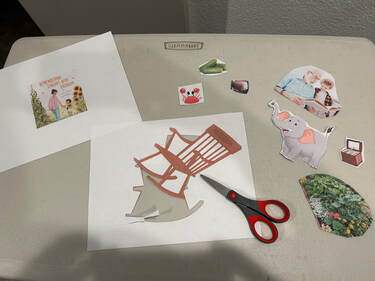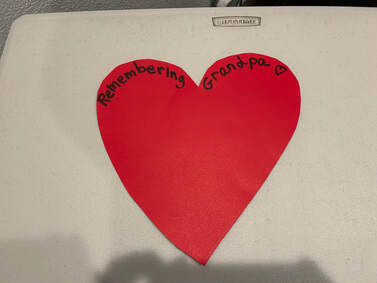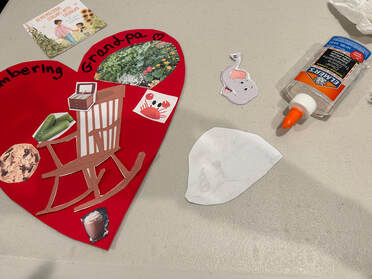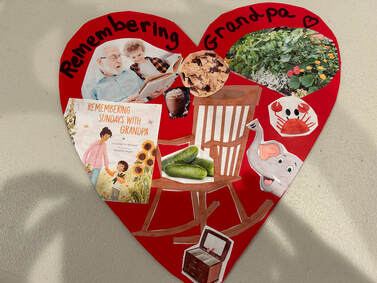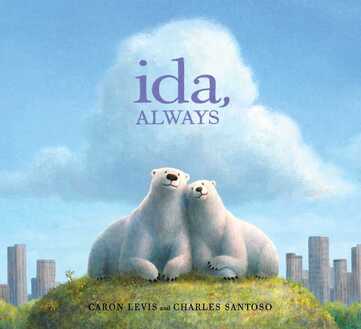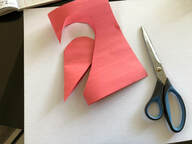|
I have returned from my blog hiatus! I spent the last few months saying goodbye to Costa Rica, where I lived for 5 years, and resettling in Seattle, Washington. I have started a new job in which I am doing Infant Mental Health work with 0- 3 year olds. With this in mind, I may be exploring some board books, in addition to picture books, for an even younger age range of readers. Well, listeners! I'm excited to be back and have an exciting line-up of children's books to review for 2024! The first in line is a new story about coping with the loss of a grandparent by one of my favorite therapist authors - Lauren Kerstein! Let the Children GrieveA Book Review of Remembering Sundays With Grandpa
The first point that is highlighted in this book is encouraging open discussion of the loss and feelings surrounding it. As adults, we want to protect our children from pain. In doing so, we sometimes unwittingly create more long-term pain. Nobody wants to see a sad child. However, there are things in this life that we are unable to protect our children from. One of those things is grief. If we love and build connections with others, which is crucial to healthy existence, eventually we will lose someone we love and are connected with. Unfortunately, sometimes this happens when we are very young. The parent in this story has created an open environment in which the child feels safe talking about hard things. This is demonstrated in the following quote: "Henry dragged himself downstairs to his mom. 'I miss Grandpa,' he said. 'I don't want him to be gone.'" Mom does not make him shove those feelings down by trying to ignore them. She addresses them head-on by saying "I don't either." Rather than trying to fix it, she normalizes it by stating that she also shares that feeling. Henry and his mom then hug and the narrator says, "Sometimes hugs were better than words." Already, by the second spread of this book, we have learned that acknowledgement of feelings and human connection are the recipe for healthy coping. The courage on the part of this parent to allow their child to feel, is also displayed by the photo on his bedside table. This will be a constant reminder of the loss, which is going to feel sad sometimes. However, it's okay to feel sad as our memories of the connection will get us through. That is a message that will lead to healthy grieving. This brings me to the second element that is so important when dealing with a grieving child. Many parents try to hide their own feelings, hoping to avoid stirring up sadness in their child. This often backfires as it leads to the child feeling alone with their pain and does not normalize the often crushing feelings from loss. It is okay for the adult to share their own sad feelings. This helps the child not feel alone with their emotions and promotes the message that We'll get through these tough time TOGETHER. Cry together, remember together, grieve through that connection. That will lead to healthy coping. The third point, and crucial in my opinion, is demonstrated in the following exchange in the book: " 'Why did he have to die?' Henry asked. 'His body was too fragile to stay, but his love will live on forever,' his mom said." Many religions believe in Heaven and life after death and many parents feel that "Grandpa went to Heaven" will cut the pain and be comforting to their children. However, this is too abstract of a concept for children in this age range. Children are in a concrete stage of thinking until about 12 years of age. Therefore, they require a concrete explanation, like "His body was too fragile to stay" or "His body stopped working." This is a much clearer explanation for children within this age group and will not lead to confusion. In my practice, when told their relative has gone to Heaven, I have often heard children say "I want to die too so I can go to Heaven with Grandpa," or "When is he coming back?" Another response I've heard is that of abandonment, "Why did Grandpa choose to go without me?" Again, sometimes our goal of protecting the child from pain unwittingly creates more pain. While highlighting the important elements that lead to healthy grieving in children, Lauren found a way to keep the story light and fun for young children. The book progresses like a Treasure Hunt, with both mom and Henry looking for Grandpa's love all around them. Lauren does this by tapping into sensory memories. For example: Touch/motion: The rocking chair where Grandpa read to Henry, dancing to the jewelry box music Sight/taste/smell: The garden where Grandpa grew his favorite cucumbers Taste: Chocolate chip cookies dunked in hot chocolate Sight: Grandpa's silly faces Hearing: Cucumber hiccups, repeating the silly sounds Grandpa made, ie. trumpeting like an elephant, The senses help us access our memories and emotions. It's a common experience in grieving that you're happily going about your life, and a certain smell, taste, feeling, sight or sound hits you like a ton of bricks and suddenly tears are running down your face. You are caught off guard. What just happened? When thinking about it, you notice that something coming in from your senses lit up a memory and a feeling in your brain and made you react before even realizing it. Many experiences through the senses provoke memories that are comforting and grounding. The feeling is so real that it gives us a sudden message that Yes, we were connected to this person. And that feels good, like a worm cup of hot chocolate. This book not only encourages kids and their parents to engage in healthy grieving, it leaves the young reader with a sense of hope. Grandpa will live on through them through their facial expressions, dimples, beauty marks, and, most importantly, in their hearts. The illustrator, Nanette Regan, captures this hope through the vibrant colors, flowers, plants, butterflies and other living things throughout the book. She doesn't shy away from sad expressions, although shows the joy of remembering and continuing to live through her lively illustrations. If you'd like to read a blog post and see an interview from this author on another one of her great books, check out my blog post from April, 2021. To purchase this book or check out other books by this author, click here. As always, I have included an activity idea to go along with this book. An Activity Idea for Remembering Sundays with Grandpa.Find the Love Let's go on a Treasure Hunt through our memories, creativity and maybe even the Internet to find the love of our cherished person who has died. Materials: -Our treasured memories -Computer -Printer -Photos (optional) -Large cardstock or poster board in loved one's favorite color -Black Marker -Glue
6 Comments
A Book Review of ida, ALWAYS
This book was inspired by a true story of a real polar bear friendship at the Central Park Zoo in New York City. ida ALWAYS presents love and loss in a deeply touching and insightful manner. It taps deep into the human (and bear) experience of connection and the deep feelings that illness and death elicit in all of us. Ms. Levis describes intense sensory experiences of sounds, sights, touch, smells and taste to gently, but deeply, address the human emotion. They are successful in explaining death and dying in a clear, matter of fact way rather than resorting to abstract concepts that confuse children further. The use of sensory experiences, along with a well done, age-appropriate explanation of death and dying sets this book apart from other books on loss. It is a true lesson for adults to understand the importance of informing and including children in the process of death of a loved one or their own impending death. As adults, our knee-jerk response in dealing with a child's experience of the death and dying of a loved one, or their own impending death is to shield them from it. After all, our role as parents, teachers, family members is to protect children. Shouldn't we then continue this role when it comes to death and dying? One of the most difficult things in this world is seeing a child in pain, whether it be physical or emotional. It's easier for us to pretend with the child and give them false hope. However, the reality is that in trying to protect the child, as adults we are actually causing the child to feel more pain in the long run. We must allow our children to feel and understand throughout the process. We cannot protect our kids from the realities of life. We can offer them age-appropriate, clear explanations that make life less mysterious and less scary. We can prepare them intellectually and emotionally. Even though they will go through the pain, as we do as adults, they will have the opportunity to express their strong feelings throughout the process and begin to grieve. They will feel safe asking questions and expressing their love to their loved ones in their last precious days together. This book is an excellent way to start this conversation. Gus and Ida, the bear friends in the story, are granted the opportunity to feel. The very caring and compassionate zookeeper, Sonya, does a beautiful job explaining Ida's illness and impending death to Gus in a gentle but straightforward manner. The story moves forward with Gus and Ida expressing their very strong feelings together. They show their anger at the situation by growling, howling, stomping and snarling together. They express their sadness together and the unknown and the wonderings of what will be. Through Charles Santoso's beautiful illustrations, you can feel the deep connection between the bears and the intense feelings they experience. The story oozes with compassion and empathy through all of the characters. Gus's knowledge of Ida's impending death allows him to be part of the care-taking process. He is able to do what he can to help care for her in the last days of her life. This care-taking process is crucial and helps tremendously with our feelings of helplessness in the situation. As I remember back to the deaths of my grandparents and parents, a very warm memory that I carry with me, is the small things I was able to do that made me feel like I was playing a role in helping them feel comfortable in their dying moments. The story goes on to show the transition of Gus's life after Ida's death. The sadness shown through Gus's character allows the readers to sit with the sadness. The quote in the book that feels the most important to me is "You don't have to see it to feel it." This quote has a double meaning in the story describing the sensory experiences of the bustling city around them, in addition to Gus's ability to feel Ida with him after her death. I highly recommend this book for children, and adults, who are experiencing any loss, especially one through illness or their own impending death. I have included an activity below to help personalize this grieving process for the child. Activity Idea for ida, ALWAYSA very useful exercise to assist with grieving is to write a letter to the loved one that has passed. This can be done repeatedly to express feelings, things remembered and missed, and as a way to feel you are updating them with ongoing life. I have composed a letter template that can be completed through writing or drawing or both, that can be used with your child, client or student to assist them through the grieving process. The template focuses on the ideas expressed in the book. It might be very helpful to first have the child answer the questions as Gus might answer them if he was writing a letter to Ida. Then, they can personalize to themselves. I recommend encouraging children to draw pictures for the loved one. This has the added benefit of providing the child with expressing these thoughts and memories through the sensory experience of drawing and coloring, which is therapeutic in itself. This letter likely will need to be done over several sessions as to not be overwhelming. Younger children may need reminders of some of their memories and more prompting. The letter ideas are written below and I have included a link to a printable pdf file with room for pictures below. Dear_________________________, 1. I remember when we: 2. When you were sick, it was so sad when: it was so scary when: 3. I wish we could have: 4. You made me laugh when: 5. I liked helping you with: 6. The things I miss the most about you are: 7. These are the things I hear, see, taste, smell, touch, that remind me of you: Love, _________________
A Book Review of The Invisible String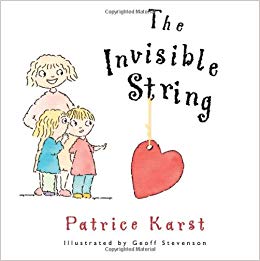 The Invisible String Written by: Patrice Karst Illustrated by: Geoff Stevenson Publisher: DoVorss & Co., CA Welcome to my first Blog post!! I thought Valentine's Day would be a perfect day to kick off my first post with this lovely book about connections of the heart. I am dedicating this post to my former Infant Mental Health team at Easter Seals Michigan. Due to the intensity of our work together, working with vulnerable young children and their families, we developed very strong connections to each other. This book became a frequent go-to for all of us in dealing with loss in young children. In my opinion, this book is most appropriate for children from three to eight years of age, but truly it resonates with people of all ages in providing comfort in the event of a loss. After all, loss is a universal experience that, like it or not, we all experience at one time or another and in one way or another. It is a painful experience that parents simply cannot protect their kids from, nor should they try. Liza and Jeremy were twins that became scared one night from a thunderstorm and ran out of their room and into their mother's arms. This situation is a frequent occurrence and common fear that many kids can relate to. Ms. Karst does a beautiful job showing appropriate expression of feelings of Liza and Jeremy throughout the book, as does Mr. Stevenson through the illustrations. This is a beautiful, comforting book that subtly touches on the many losses we incur in our lifetime. It presents the concept that we never really lose people we love, they stay in our hearts forever-always connected through that invisible string! Ms. Karst's creative concept of "the invisible string" is a magical concept that adds to the anticipation and mystery that draws kids into the book. At the end of the story, Liza and Jeremy are able to withstand the storm in their own beds comforted by their new knowledge that the people they love are always with them, even if not physically. I have used this book so much in my practice that I have worn it out! It is very useful with kids who have been separated from their families through foster care or adoption, jail, or death. I have found it helpful for military families when kids have a parent serving overseas. It is also useful for kids with separation anxiety and for just the day to day life happenings of a child, ie. staying in their own bed at night, starting preschool or Kindergarten, or missing their non-custodial parent who no longer lives with them. This story strongly resonates with children and adults alike and provides a comfort that only connection and relationships can provide when going through difficult times. I use this book as a great starting point to address all of the losses stated above. Many times, I follow the reading of this book by a therapeutic activity, to drive the concepts home.
|
|||||||||||||||||||
| Directions 1. Cut out large heart from construction paper, in child's favorite color, and write child's name in the middle of the heart. Note: Work together with the child and parent, cutting if child is too young, having child pick out the colors and write name if they can. To make the hearts, I simply fold paper and make them the old fashioned way! Kids love the magic of opening up the shape after it's cut and seeing the heart! See photos. 2. Cut strings and tape on back of large heart. See photos. |
| 4. Have child pick out color for each of his/her connections and cut out smaller heart for each one. You can trace the first heart you cut so they are all about the same size. (Don't forget to let the kids do the "magic" by opening the heart!) Write the connection's name on heart using child's name for that person. |
| 6. FINISHED PROJECT! During and/or after activity, discuss favorite memories they have about each connection. Suggest to parent/guardian to hang project in the house somewhere where child can see it often. Drive home the message "Even though ______ isn't with you now, you are ALWAYS CONNECTED by the invisible string! You are in each other's hearts forever and no one can take that away from you." |
Follow me on twitter
Follow me on Twitter, Pinterest and LinkedIn
Categories
All
Absent Dad
Acceptance & Commitment -Therapy Skills
Acceptance Of Others
ADHD
Adoption
Anger Management
Anxiety
Body Autonomy
Cognitive Behavioral Therapy Skills
Consent
Coping With ADHD
Coping With Depression
Coping With Feelings
Depression
Disability Awareness
Disappointment
Divorce
Domestic Violence
Empathy
Fear
Feelings General
Feelings-General
Foster Care
Gender Identity
Giftedness
Grandparents As Guardians
Grief & Loss
Growth Mindset
Incarcerated Parent
Kindness
Kinship Care
Learning Disabilities
Making Friends
Mindfulness
Negative Self Talk
Parental Anger
Parental Arguing
Parent W/Mental Illness
Parent W/Substance Abuse
Racial Injustice
School Lockdown Drills
Seizures
Self Esteem
Sensory Issues
Separation Anxiety
Sexual Abuse
Sexual Abuse Prevention
Shyness
Standing Up For Others
Suicide
Supporting A Friend
Temper Tantrums
Terminal Illness
Trauma
White Privilege
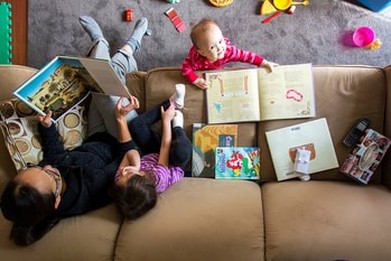
 RSS Feed
RSS Feed
